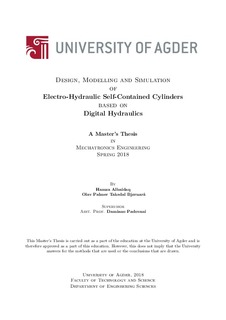| dc.contributor.author | Albaidaq, Hamza | |
| dc.contributor.author | Bjørnarå, Olav Palmer Taksdal | |
| dc.date.accessioned | 2018-09-21T10:05:21Z | |
| dc.date.available | 2018-09-21T10:05:21Z | |
| dc.date.issued | 2018 | |
| dc.identifier.uri | http://hdl.handle.net/11250/2563867 | |
| dc.description | Master's thesis Mechatronics MAS500 - University of Agder 2018 | nb_NO |
| dc.description.abstract | Nowadays, hydraulic cylinders are mostly powered by a separate HPU and controlled by conventional
servo and proportional valves. New trends have been under development the last years. The first trend
is self-contained designs where the power unit is integrated in the cylinder design. Digital hydraulics
is the second new trend where conventional flow control methods are replaced by simple ON/OFF
valves and digital displacement pumps.
A totally novel design would be a combination of the two mentioned trends. Designing a hydraulic
cylinder that combines both the self-contained method and digital hydraulics is expected to results in
many gained advantages. It would be a totally new system that has never been investigated earlier. It
was not possible in the project period to find any existing products or publications related to this idea.
In this master thesis, different approaches are proposed for designing an electro-hydraulic self-contained
cylinder, based on digital hydraulics. The start is a literature review of relevant publications about
digital hydraulics and self-contained hydraulic cylinders. Benefits of digital hydraulics and the selfcontained
designs are presented.
The design process is divided into two main stages. The first is designing different concepts of the
hydraulic architecture of an electro-hydraulic self-contained cylinder based on digital hydraulics that
includes both ON/OFF valves and digital displacement pumps. The second stage is to develop different
control approaches that can implemented on the hydraulic architectures designed in the first stage.
The most significant hydraulic components used in the hydraulic design are modelled in MATLABSimulink.
The proposed control algorithms are also built in MATLAB-Simulink models.
Five combinations of hydraulic architectures and control approaches are selected to cover all the proposed
hydraulic and control systems. The combinations are then simulated with a generic load case
to investigate the functionality and controllability of all systems. The most significant results such as
accuracy and pressure progression are presented and analysed.
Lastly, a kinematic model of a single boom crane standing in the laboratory of the University of Agder
has been implemented as a load case for one of the combinations. The goal was to investigate the
possibility to drive the crane by one of the systems designed in this thesis. The results ware sufficient
and indicated the feasibility of such a solution.
The results achieved in this thesis give a clear indication that an electro-hydraulic self-contained
cylinder design is achievable with digital hydraulics. Many advantages are gained, such as reliability
and load holding capability. A last hydraulic architecture is proposed at the end for future work to
enhance the efficiency and enable the possibility of recovering energy | nb_NO |
| dc.language.iso | eng | nb_NO |
| dc.publisher | Universitetet i Agder ; University of Agder | nb_NO |
| dc.rights | Attribution-NonCommercial-NoDerivatives 4.0 Internasjonal | * |
| dc.rights.uri | http://creativecommons.org/licenses/by-nc-nd/4.0/deed.no | * |
| dc.subject | MAS500 | nb_NO |
| dc.title | Design, Modelling and Simulation of Electro-Hydraulic Self-Contained Cylinders based on Digital Hydraulics | nb_NO |
| dc.type | Master thesis | nb_NO |
| dc.subject.nsi | VDP::Teknologi: 500::Informasjons- og kommunikasjonsteknologi: 550::Teknisk kybernetikk: 553 | nb_NO |
| dc.subject.nsi | VDP::Teknologi: 500::Maskinfag: 570 | nb_NO |
| dc.source.pagenumber | 112 s. | nb_NO |

